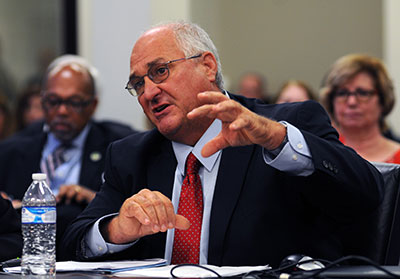By Jacqueline Pitts, The Bottom Line

Highlights:
- Two Democratic plans were heard but did not pass.
- House Bill 2: move funds from retiree health plan into pension plan and would not allow exit from the pension system for regional universities and other quasi-governmental agencies.
- House Bill 3: freeze of contribution rates for agencies for one year. Separated from House Bill 2 in case legislation gets hung up in the courts as many bills have in recent years.
- Bevin’s plan, which is very similar to the bill passed in 2019 regular session with improvements, passed through committee and moves to House floor for a vote on Monday.
On Saturday, the House State Government Committee heard three pension proposals, one by Kentucky Gov. Matt Bevin and legislative leaders and two bills introduced by the House Democratic caucus. House Bill 1 was voted on favorably and moves forward to the full House while the other two bills were not passed.
The Republican proposal, House Bill 1, is very similar to the bill that passed the General Assembly during the 2019 regular session which would allow an exit strategy for regional universities and quasi-governmental agencies from the Kentucky Retirement System (KRS) as they face bankruptcy due to pension costs and freeze their contribution rate at 49 percent.
House Bill 1, presented by Rep. James Allen Tipton, R-Taylorsville, would allow Kentucky’s regional universities and other quasi-governmental agencies to move new employees of their institutions into a new plan, more like a 401k, to ensure pension costs do not continue to hinder their budgets if they choose to do so. If an entity decides to exit the system, they will pay off their unfunded liability to the pension plan over a set number of years so the system is not left with the cost of their employees. The Republican proposal passed through the committee with a vote of 11-8.
Rep. Joe Graviss presented House Bill 2, one of the Democratic pension proposals. House Bill 2 would redirect funds currently going into the retiree health insurance plan into the pension fund for the next five years. According to the plan, the funds would be paid back in future years by higher annual payments to the retiree health insurance fund. The bill also institutes a floor for dollar contributions at the 2018-19 levels which Graviss says would help incentivize government agencies to keep employees rather than contracting out for their services.
The main difference between the Republican and Democratic plans comes down to whether or not the quasi-governmental agencies should stay in the system as House Bill 2 lays out or allowing the agencies an exit strategy to have a more stable long-term retirement strategy for their employees if they choose to get out.
The Democratic caucus originally put forth a plan that would have changed assumption rates including raising the payroll growth assumptions from 0 percent to 1 percent and bumping up the assumed rate of return of investments up to 6 percent from the current 5.25 percent. Those rates have been lowered by the system itself because they were not being met and causing larger issues for the plan overall. The changes discussed by the Democrats was not included in the final proposal.
Graviss noted a criticism of the bill is that it would cost the state and taxpayers an additional $3 billion because freezing the contribution rates shifts that cost from the employer to the state but argued it’s a small chunk of the overall state budget.
House Bill 2 failed with 11 members voting no, seven members voting yes, and one member passing on the vote.
House Bill 3, the other Democratic proposal, would have also implemented the freeze of contribution rate for the quasi-governmental agencies at the 49 percent they were at before July 1 and would be retroactive in order to ensure the current increased rate of 84 percent is not what is paid when the bill comes due in August. This component is just separated into a separate bill unlike House Bill 1, where the freeze and other aspects are all together in one bill.
Rep. Angie Hatton, D-Whitesburg, said she knows only a freeze is not a real solution to the pension issue, but added the proposal is put forth in case what is passed by the legislature gets hung up in the courts if the attorney general sues over the bill, which has happened often in recent years.
House Bill 3 also failed with 11 members voting no, seven members voting yes, and one member passing on the vote.
House Bill 1 now moves to the full House for a vote on the floor when they convene again on Monday. It will then be received in the Senate and considered for a vote in committee on Tuesday before a full Senate vote on Wednesday. Stay tuned to The Bottom Line for more updates from the special session.





















Add Comment